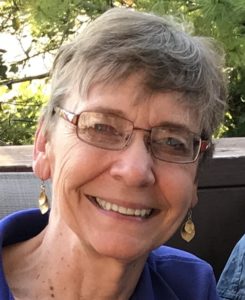Blog

Teaching Artist Spotlight: Barbara Schelstrate

This month, we are thrilled to spotlight Teaching Artist Barbara Schelstrate! In addition to ArtStream, Barbara is a valued contributor to the local music scene. She is musical director for Gilbert & Sullivan productions and annual CHAWbarets at the Capitol Hill Arts Workshop (CHAW) in D.C., as well as a dozen productions at the Unitarian Universalist Church of Arlington (UUCA). Her onstage experience includes several operas with the Washington National Opera chorus and William Inge’s Picnic with Dominion Stage. Perhaps her favorite activity is composing music: she’s written a one-act opera, Frigga & the Mistletoe, and a musical version of Shakespeare’s A Midsummer Night’s Dream, which was performed in 2011 at UUCA and in 2017 at CHAW.
Barbara took time to chat with us about her experience as a music director and member of the ArtStream community.
ArtStream: How did you first get involved with ArtStream?
Barbara: My involvement with ArtStream started much like that of many other teaching artists —through connections with other arts organizations. Sometime around 2010, ArtStream co-founder Patti Woolsey came to a show I had music directed for Arlington’s Educational Theatre Company. She approached me about working with ArtStream, but unfortunately, I had to say no because of other commitments.
However, her description of ArtStream and its mission intrigued me. So, when ArtStream came calling again in 2014, I was ready. I joined Arlington Company A with Director John Newman, and in 2015 I helped with the production of Murder on Prom Night. My husband ended up being in the show for two performances. He played the school principal who was murdered in the first scene. Many actors live for the opportunity to play a death scene, and my husband got to do that in his first dramatic performance ever!
ArtStream: Tell us about your theatre experience.
Barbara: I’ve been drawn to theatre ever since I can remember. But I also loved music – piano, theory, and composition. My first work in theatre was playing the piano for musicals. But by my high school senior year, I knew I wanted to be on stage. Who doesn’t, right?! I took my first drama class that year and played Rosie Alvarez in our senior class production of Bye Bye Birdie. Many fun plays and musicals followed in college and community theatre.
Then for a while, other pursuits took over – having a family, going to graduate school, and so on. Eventually, I found myself working as a radio news announcer. I did that in various cities – Lexington, Kentucky; Las Vegas, Nevada; and Urbana, Illinois. Finally, I came to Washington, D.C., to work at National Public Radio (NPR). I both announced on the air and also “cut tape.” The latter involved making decisions about how an interview should be edited and, physically, with a razor, cutting and splicing the tape. That was a whole new skill I had never imagined I would gain, but I really enjoyed it.
Eventually, though, I knew I had to get back to the piano and theatre. So, I quit my job at NPR and started playing for students of various violin, cello, and voice teachers. One day someone asked if I could music direct a children’s theatre musical. I didn’t know the answer to that question, but I was brave or foolish enough to give it a try. It turns out, I really liked it. I had more control over the overall sound of a show than when I was on stage. I went on to music direct many children’s musicals and shows at the Unitarian Universalist Church of Arlington and the Capitol Hill Arts Workshop in D.C.
ArtStream: What is the most important part of musical direction?
Barbara: In all my music direction jobs, I had to believe in the cause. Whether it was a school or church production or community theatre, the group’s mission mattered to me. And it’s not hard at all to believe in the mission of ArtStream. I love seeing how the actors express themselves and become bigger than life when they’re on stage. Some actors might be quiet and reserved in rehearsals, but when performance time comes, they light up the stage.
I did have my doubts early on. I didn’t know how my music compositions would go over with the group. That’s a concern every time I start with new people — “What will they think of what I write for them, and will I be able to explain it in such a way as to make sense?” I soon learned that ArtStream actors approach learning the music with such enthusiasm that I had no cause for concern.
ArtStream: How have you seen ArtStreamers grow over the course of a production?
Barbara: I continue to be wowed over by what ArtStream actors can do. One actor was fearful of improvising. Every year, with great determination, she overcame her fear in order to help us come up with a good show. By the way, she was the one who usually came up with the show’s title. Other actors have a hard time memorizing, which is true in every community theater group I’ve ever worked with. Somehow, by performance time, they get a handle on their lines. I’ve also been struck with how audience reaction motivates the actors. Getting a laugh for a funny line reading really pumps them up, which is a delight to see.
Without telling me beforehand, a friend of mine came to my first ArtStream show, “Murder on Prom Night.” Afterward, she told me she thought the whole production was excellent and very professional. And this is a person who loves theatre and has been involved in and has attended many plays. She liked our show so well that she has come to all of them since. That tells me we’re on to something. The inclusive theatre of ArtStream is art in its fullest sense. It touches people and gives them joy.
